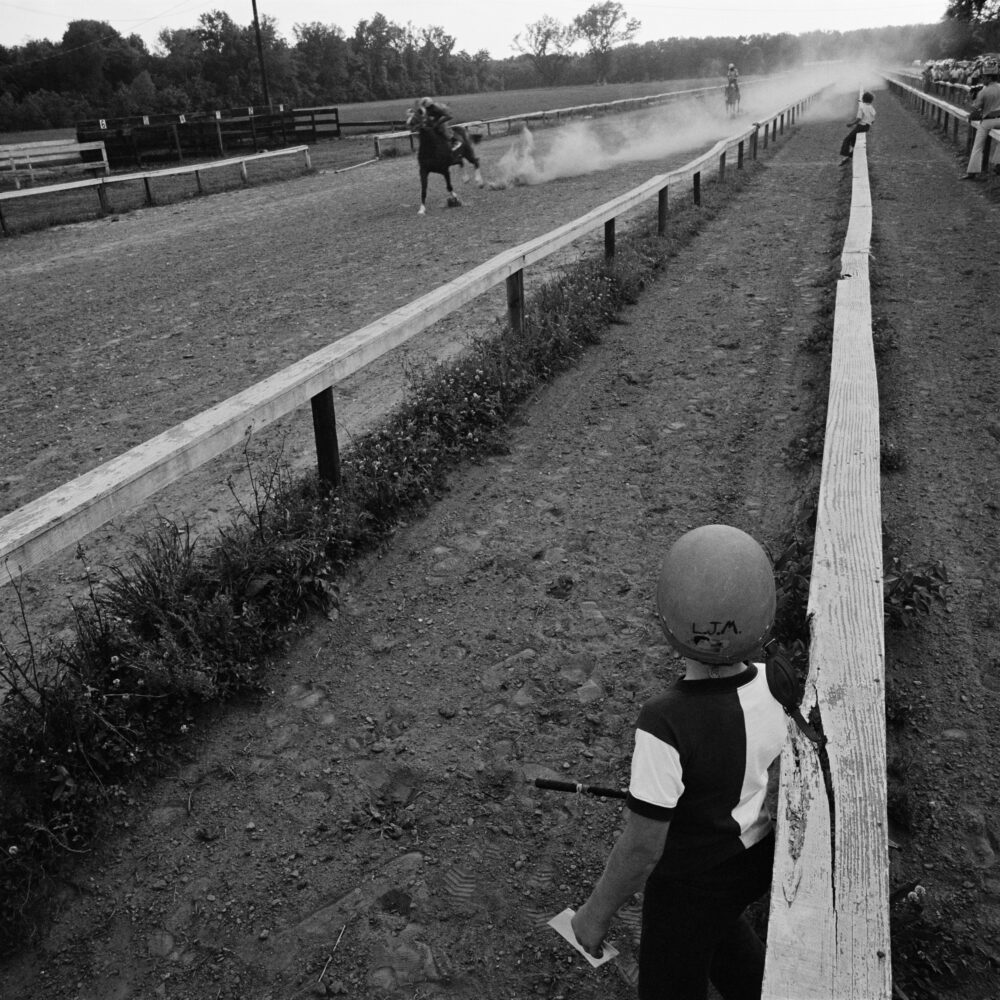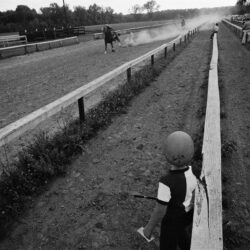Magazine
Ils Sont Partis
Bush tracks of South Louisiana
Published: June 1, 2024
Last Updated: September 1, 2024

Photo © Douglas Baz and Charles H. Traub, The Historic New Orleans Collection
Carencro Raceways, ca. 1973.
Sunlight filters through a latticework of leaves. A rusty gate, covered with vines, squeaks eerily in the wind. Gravestones, enshrouded in mist, make for a haunting scene, but it’s not the buried you will hear if you close your eyes and listen carefully. There’s the faint echo of jockeys whooping and hollering, followed by the intense pounding of hooves. Onlookers cheering. Dust settling on the skin. Faint music tickling the ear. You’re in South Louisiana, standing on the remains of a bush track.
Decades ago Carencro Raceways was defined by its mile-long, oval tracks etched deep in the dirt by the hooves of unrestrained quarter horses. Today it’s a cemetery. Places like it—the Quarter Pole, Cajun Downs, Derby Downs, Linzay Downs, Acadiana Downs—have all reverted back to pasture or become subdivisions or parking lots. Award-winning Louisiana jockeys first honed their skill here, sans saddles, fueled by their Kentucky Derby dreams. The infamous bush tracks of South Louisiana may have bruised their bottoms and egos, but they also embedded seeds of horse-racing fame into their heads.
Ask about “bush tracks” around these parts and first you’ll get a wink. These were not-so-secret racetracks hidden in rural pockets of Louisiana. Usually sited close by a pasture where mostly quarter horses were stabled and trained, the tracks were bounded by either natural landmarks or barrels. The races held here were not, however, bounded by rules; they were informal, unsanctioned and untimed, and the management was often as unpredictable as the horses and riders. But what the bush tracks lacked in structure was made up for in purpose: a place where young men tested themselves against other aspiring jockeys while escaping the humdrum of picking cotton or loading sugar cane.
“Would I’d rather ride horses and make money?” seventy-five-year-old Wayne Huval asked, sipping his coffee in a café in Henderson. “Sure. Making a buck sounded better than making next-to-nothing breaking my back and blistering my fingers in the fields. I couldn’t get to the tracks fast enough.”
Huval recalled being a rookie rider, a kid who sharpened his horse sense caring for the animals while gaining racing experience. “There was no big money in the bush tracks, although you always heard rumors,” Huval said, chuckling. “But there were also no vets or racing commissioners hanging around. You rode in whatever you showed up in, out in the middle of nowhere. They’d put lead in the saddle to run the rider-less horses, or strap in a six-pack of beer. Bush tracks were where you learned a lot about horses and people.”
Honing that sixth sense is what Fred Richard remembers most from helping his father at their track, the Quarter Pole, in Rayne. “I didn’t compete, but I sure loved watching and taking care of the horses we kept there,” he said. “Those kids who raced were passionate about their animals, dedicated to their care. It was like horse and the jockey were just one animal. It was an exciting time.”
It also was a time when many Louisiana racing legends parlayed their bush track prowess into national titles. Eddie Delahoussaye of New Iberia began riding professionally in 1968. A top American jockey, he won two consecutive Kentucky Derby races, riding Gato Del Sol in 1982 and Sunny’s Halo in 1983. Randy Romero of Erath retired in 1999 after becoming an American Hall of Fame jockey with over 4,200 winners in his career. Hall of Famer Kent Desormeaux, of Maurice, holds the US record for the most races won in a single year, 598 in 1989. Shane Sellers of Erath rode in the Kentucky Derby fourteen consecutive times, with almost 4,000 total races over the course of his career—which he began at age eleven.
Calvin Borel of Catahoula advanced from the bush tracks to become a three-time Kentucky Derby champion, riding Street Sense (2007), Mine That Bird (2009), and Super Saver (2010) to victory. In the 2011 documentary T-Galop: A Louisiana Horse Story, Borel swears the bush tracks made him want to win: “You had to be aggressive, do things you couldn’t do on a recognized track.” His brother Cecil recalls a kid so anxious to be a jockey that he’d ride chickens, pigs, goats, even the ends of the sofa—anything to feel like he had a horse under him.
Still wiry today at 107 pounds, Wayne Huval told me he’d been a runt kid who dreamt of his own “run for the roses,” riding at tracks from New Orleans to Toledo to Montreal to prepare for the Kentucky Derby. He broke his leg in a Hazel Park race in Detroit in the 1970s, ending his racing career at twenty-five. He’d been one of the nation’s top jockeys, with over two hundred winning races in the “big tracks”—and, of course, hundreds of others in the bush tracks.
Louisiana’s infamous bush tracks are all faded memories now. But Borel is still riding today. He’d hung up his saddle in March 2016, but came out of retirement in August that same year. Now in his late fifties, he admits that he cried unashamedly each time he won a Derby, wishing his parents could see how their little boy from Catahoula had made it from the sofa to the bush tracks to the Winner’s Circle.
Madelaine Brauner Landry, a native New Orleanian, writes about culture, history, business, community, and human interest for local media. She and her husband reside on the Atchafalaya River in Butte La Rose. She is also an online interpersonal communication instructor for UL Lafayette and recently completed her second novel, Caro Giovanni. Contact her at [email protected].
